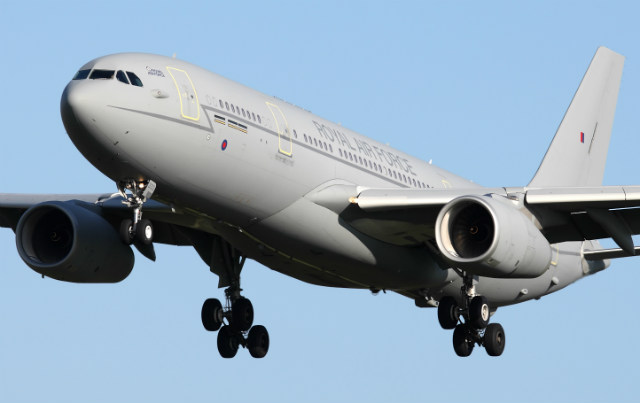An in-flight mishap involving a Royal Air Force Airbus A330 Voyager en route to Afghanistan last year has been categorised as “an extremely serious near-miss” by the director general of the UK Military Aviation Authority (MAA), following the completion of a service inquiry.
In an interim report published 12 months ago, the MAA said aircraft ZZ333 entered a steep dive from a cruise altitude of 33,000ft after its captain accidentally jammed a camera into his sidestick control as he moved his seat forwards.
Additional details of the 9 February 2014 event – which happened over the Black Sea north of the Turkish coast – were disclosed in a service inquiry published on 19 March. This shows that the widebody was out of its pilots’ control for some 33s, during which time it lost 4,400ft.
Within 10s of the forward stick input, the A330 had reached a 17˚ nose-down attitude. Its automatic high-speed protection system was triggered 3s later, with a maximum indicated air speed of 358kt (662km/h), or Mach 0.9, recorded.
As the aircraft pitched down, the aircraft’s captain – who was alone in the cockpit – attempted to disengage the autopilot and pull back on his sidestick. The co-pilot, who had been in the forward galley area for around 15min, attempted to return to his seat – although he was weightless, as the cabin encountered a maximum of -0.56g. “With his feet on the flight deck roof, the co-pilot reached down and attempted to disengage the autopilot by pulling back on his sidestick,” the report says.
With dual inputs being delivered, the A330’s flight protection system was automatically engaged. Around this time, the captain’s camera – which investigators found had last been used 3min 20s before the loss of control – was removed “by means of a physical manipulation”.
“From the onset of the pitch-down until the removal of the camera 33s later neither pilot had control of the aircraft,” the report notes. “The initial recovery from the dive was the result of the aircraft’s own protection measures, and not the product of pilot inputs.” They then set the thrust levers to idle and raised the aircraft’s nose, before selecting take-off and go-around power and regaining straight and level flight at 31,000ft.
The report says the captain – who initially suspected an autopilot failure – considered switching off the A330’s air data and inertial reference units, in order to bring it under “direct law” control. Had this been done, “the aircraft’s self-protection measures for overspeed and pitch would have been disabled [and] the certified limit of 365KIAS would have been exceeded by a significant margin, potentially leading to significant damage to the aircraft”, the report says.
According to the report, “this was the first flight control/object/armrest interaction of this nature to be reported” to Airbus from over 190 million flight hours with the A330 family of aircraft. However, investigators found 26 instances where the autopilot had been inadvertently disconnected during a Voyager flight between April 2012 and March 2014. None of these had been recorded using a flight safety reporting system, it notes.
Damage to the aircraft – which encountered a maximum 2.06g during the recovery – was limited to seven dented ceiling panels, 50 damaged in-flight entertainment sockets and other minor damage. The captain’s sidestick controller was also subsequently replaced, after Airbus assessed that the forces placed on it were beyond its design specification. “Up to 24% of the aircraft occupants were rendered temporarily unfit for duties following the incident,” the report adds, referring to 25 passengers and seven crew members.
The inquiry also describes a crew decision to decline a Turkish air traffic offer to land at Trabzon – some 60nm (110km) away – following a Mayday call and instead request a 500nm diversion to Istanbul as below the standard expected. They later accepted a 340nm diversion to Incirlik air base, despite having encountered “a highly unusual emergency and [having] a potentially damaged airframe”.

AirTeamImages
“Without the excellent technology of the Airbus A330 flight control laws, the outcome could have been very different, with the realistic potential for the loss of the aircraft and 198 of our people,” MAA director general AM Richard Garwood says in his summary of the incident.
“Modern technology may be capable of reducing crew workload to historic lows and aircraft can now protect themselves as never before, but the requirement for crews to understand and interact with the aircraft and its systems when things deviate from the norm remains as challenging as ever.”
Source: FlightGlobal.com



















